|

Reference Guide
|
|
Using the Printer Driver / For Macintosh
Mac OS X Users
 Installing the printer driver
Installing the printer driver
 Selecting the printer driver
Selecting the printer driver
 Printer driver settings
Printer driver settings
 Installing the PostScript printer driver (EPL-6200 only)
Installing the PostScript printer driver (EPL-6200 only)
 Selecting the PostScript printer
Selecting the PostScript printer
 Changing the printer setup settings
Changing the printer setup settings
 PostScript printer driver settings
PostScript printer driver settings
Installing the printer driver
The printer driver is included in the CD-ROM that shipped with your printer. For instructions on installing the printer driver, see the Setup Guide.

[Top]
Selecting the printer driver
The procedure for selecting the printer varies depending on the protocol or interface used to connect the printer to your computer.
 |
Note:
|
 | |
You need to make the settings for your installed options manually when the printer is connected using USB, IP printing, or Rendezvous. When the printer is connected using AppleTalk, the printer software automatically makes the settings.
|
|
AppleTalk
Follow these steps to select the printer when it is connected using AppleTalk:
 |
Go to the Utilities folder located inside the Applications folder, and then double-click Print Center.
The Printer List window appears.
|

 |  |
Note:
|
 |  | |
If you are launching the Print Center for the first time, or there is no printer added to the Print Center yet, the following screen appears:
|
|
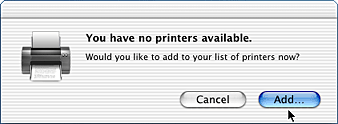
 |  | |
Click Add, and proceed to step 3.
|
|
 |
Click Add in the Printer List window. Alternatively, you can select Add Printer from the Printers menu.
|
 |
In the window that appears, choose AppleTalk from the pop-up list.
|
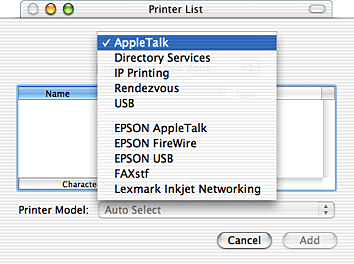
 |
Select your printer name from the Name list, and then select Auto Select in the Printer Model pop-up list.
|
 |  |
Note:
|
 |  | |
By default, the six-digit MAC address is displayed after the printer name.
|
|
 |
Click Add. The installation program starts communicating with the printer.
When communication is established and configuration is completed, your printer is automatically added to the Printer List.
|
 |
Quit Print Center.
|
IP Printing
Follow these steps to select the printer when it is connected using IP Printing:
 |
Go to the Utilities folder located inside the Applications folder, and then double-click Print Center.
The Printer List window appears.
|

 |  |
Note:
|
 |  | |
If you are launching the Print Center for the first time, or there is no printer added to the Print Center yet, the following screen appears:
|
|

 |  | |
Click Add, and proceed to step 3.
|
|
 |
Click Add in the Printer List window. Alternatively, you can select Add Printer from the Printers menu.
|
 |
In the window that appears, choose IP Printing from the pop-up list.
|
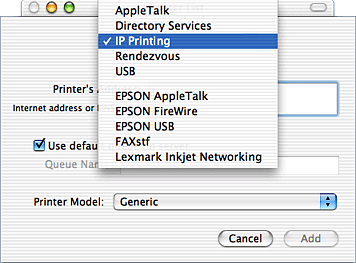
 |
Enter the IP address for the printer.
|
 |  |
Note:
|
 |  | |
See the Network Guide or consult your network administrator for information about the IP address for the printer.
|
|
 |
Make sure that the Use default queue on server check box is selected.
|
 |
Select Epson from the Printer Model pop-up list. The Model Name list box is displayed.
|
 |
Select your printer model from the Model Name list.
|
 |
Click Add. Your printer's IP address is automatically added as a printer name to the Printer List.
|
 |
Select your printer's IP address from the list, and then select Show Info from the Printers menu. The Printer Info dialog box appears.
|
 |
Select Installable Options from the pop-up list, and make the necessary settings.
|
 |
Click Apply Changes, and then close the Printer Info dialog box.
|
 |
Quit Print Center.
|
USB
Follow these steps to select the printer when it is connected using the USB interface:
 |
Note:
|
 | |
Make sure to select the printer by using the procedure described below. The Plug and Play function automatically selects the printer when the printer is connected via the USB interface. However, this automated selection may not work properly.
|
|
 |
Make sure that the printer is properly connected to your computer with an USB cable, and that the printer is turned on.
|
 |
Go to the Utilities folder located inside the Applications folder, and then double-click Print Center.
The Printer List window appears.
|

 |  |
Note:
|
 |  | |
If you are launching the Print Center for the first time, or there is no printer added to the Print Center yet, the following screen appears.
|
|

 |  | |
Click Add, and proceed to step 3.
|
|
 |
Click Add in the Printer List window. Alternatively, you can select Add Printer from the Printers menu.
|
 |
In the window that appears, choose USB from the pop-up list.
Your printer name automatically appears in the Name list.
|
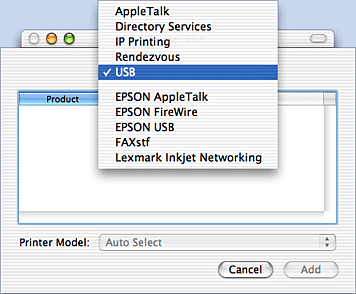
 |
Make sure that your printer model is selected in the Printer Model list.
|
 |
Click Add. Your printer is automatically added to the Printer List.
|
 |
Click on your printer name on the list, and then select Show Info from the Printers menu. The Printer Info dialog box appears.
|
 |
Select Installable Options from the pop-up list, and make the necessary settings.
|
 |
Click Apply Changes, and then close the Printer Info dialog box.
|
 |
Quit Print Center.
|
Rendezvous
There are two ways to select the printer when it is connected using Rendezvous.
Selecting in the Print Center
Follow these steps to select the printer from the Print Center:
 |
Go to the Utilities folder located inside the Applications folder, and then double-click Print Center.
The Printer List window appears.
|

 |  |
Note:
|
 |  | |
If you are launching the Print Center for the first time, or there is no printer added to the Print Center yet, the following screen appears.
|
|

 |  | |
Click Add, and proceed to step 3.
|
|
 |
Click Add in the Printer List window. Alternatively, you can select Add Printer from the Printers menu.
|
 |
In the window that appears, select Rendezvous from the pop-up list.
|
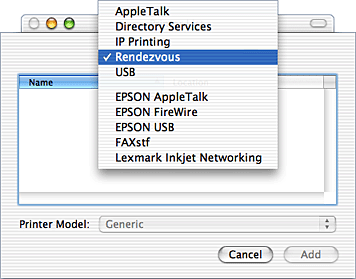
 |
Select your printer from the Name list. The printer name should have attached to the end.
|
 |
Make sure that your printer model is selected in the Printer Model list.
|
 |
Click Add. Your printer is automatically added to the Printer List.
|
 |
Click on your printer name on the list, and then select Show Info from the Printers menu. The Printer Info dialog box appears.
|
 |
Select Installable Options from the pop-up list, and make the necessary settings.
|
 |
Click Apply Changes, and then close the Printer Info dialog box.
|
 |
Quit Print Center.
|
Selecting from an application
Follow these steps to select the printer from within an application:
 |
Start an application, and then select Print from the File menu.
|
 |
In the window that appears, select Rendevous Printer from the Printer pop-up list.
|
 |
From the list of printers that appears, select your printer model.
|

[Top]
Printer driver settings
To control your printer and change its settings, use the printer driver. The printer driver allows you to easily make all the print settings, including paper source, paper size, and orientation. To access the driver menus, see below.
To access the printer driver from Mac OS X, register your printer in Print Center, then click Print on the file menu of any application and select your printer.
Choosing the print quality (EPL-6200 only)
 |
Note:
|
 | |
The print quality setting for the EPL-6200L cannot be changed. It prints at 600 dpi only.
|
|
You can change the print quality or resolution of printouts to favor speed or detail. If you need high quality output, choose a higher number. Please note that doing so reduces the print speed.
There are three levels of print output, 600 dpi, Class 1200 dpi, and 1200 dpi. Class 1200 dpi provides high quality printing results on par with 1200 dpi with the Enh.MG and RITech functions (under 600 dpi).
 |
Open the Basic Settings dialog box.
|
 |
Click the Automatic button, then choose the resolution from the Resolution drop-down list.
|
 |  |
Note:
|
 |  | -
If printing is unsuccessful or a memory-related error message appears, selecting a lower resolution may allow printing to proceed.
|
|
 |  | -
For details of the Enh.MG or RITech functions, see the Online Help.
|
|
Modifying the print layout
"Layout printing" prints either two or four pages onto a single page and to specify the printing order, automatically resizing each page to fit the specified paper size. You can also choose to print documents surrounded by a frame.
 |
Open the Print dialog box.
|
 |
Select Layout from the drop-down list.
|
 |
Select the number of page you want to print on one sheet of paper from the drop-down list.
|
 |
Click Print to start printing.
|
 |  |
Note:
|
 |  | |
The Layout settings are a standard feature of Mac OS X.
|
|
Printing with the Duplex Unit (EPL-6200 only)
Duplex printing prints on both sides of the paper. When printing for binding, the binding edge can be specified as required to produce the desired page order.
 |
Open the Print dialog box.
|
 |
Select Duplex Settings from the drop-down list.
|
 |
Select the Duplex Settings check box.
|
 |
Select a Binding position from Left, Top, or Right.
|
 |
Specify the Binding Margin for the front and back sides of the paper.
|
 |
Select whether the front or back side of the paper is to be printed as the Start Page.
|
 |
Click Print to start printing.
|
Avoiding Insufficient Memory Error (EPL-6200L only)
When you print graphics or a large amount of data, the printer may stop due to insufficient memory. Follow the steps below to avoid memory errors and continue printing.
 |
Note:
|
 | |
Print quality will decrease when you use this function.
|
|
 |
Open the Extension Settings dialog box.
|
 |
Select the Avoid Insufficient Memory Error check box.
|
 |
Click OK to accept the settings.
|

[Top]
Installing the PostScript printer driver (EPL-6200 only)
The PS Installer program that is included in the printer software CD-ROM installs the PostScript 3 printer driver.
Make sure that no applications are running on your Macintosh before installing the printer driver. If applications such as the Print Center is running, the printer driver cannot be installed properly.
Follow these steps to install the printer driver:
 |
Turn on your Macintosh if it is not already on.
|
 |
Insert the printer software CD-ROM into your CD-ROM drive.
|
 |
Double-click the CD-ROM icon, and then double-click Mac OS X.
|
 |
Double-click PS Installer. The Authenticate window appears. Make sure to enter the user name and password for an administrator.
|
 |  |
Note:
|
 |  | |
You need to login to Mac OS X as an administrator in order to perform software installations.
|
|
 |
In the welcome screen that appears, click Continue, and follow the on-screen instructions.
|
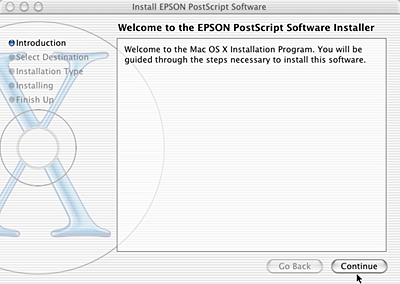
 |
When the following screen appears, click Install.
|
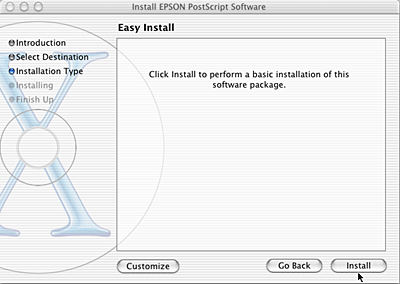
 |
When installation is done, click Close.
|
This completes the installation of the PostScript 3 printer driver. You now need to select the printer as described in the next section.

[Top]
Selecting the PostScript printer
The procedure for selecting the printer varies depending on the protocol or interface used to connect the printer to your computer.
 |
Note:
|
 | -
You cannot use FireWire for printer connection in the PostScript 3 mode. Although EPSON FireWire appears in the interface pop-up list, it cannot be used with the PostScript 3 printer driver.
|
|
 | -
You need to make the settings for your installed options manually when the printer is connected using USB, IP printing, or Rendezvous. When the printer is connected using AppleTalk, the printer software automatically makes the settings.
|
|
AppleTalk
Follow these steps to select the printer when it is connected using AppleTalk:
 |
Go to the Utilities folder located inside the Applications folder, and then double-click Print Center.
The Printer List window appears.
|

 |  |
Note:
|
 |  | |
If you are launching the Print Center for the first time, or there is no printer added to the Print Center yet, the following screen appears:
|
|

 |  | |
Click Add, and proceed to step 3.
|
|
 |
Click Add in the Printer List window. Alternatively, you can select Add Printer from the Printers menu.
|
 |
In the window that appears, choose AppleTalk from the pop-up list.
|

 |  |
Note:
|
 |  | |
Make sure to choose AppleTalk. Do not choose EPSON AppleTalk, because it cannot be used with the PostScript 3 printer driver.
|
|
 |
Select your printer name from the Name list, and then select Auto Select in the Printer Model pop-up list.
|
 |  |
Note:
|
 |  | |
By default, the six-digit MAC address is displayed after the printer name.
|
|
 |
Click Add. The installation program starts communicating with the printer.
When communication is established and configuration is completed, your printer is automatically added to the Printer List.
|
 |
Quit Print Center.
|
IP Printing
Follow these steps to select the printer when it is connected using IP Printing:
 |
Note:
|
 | |
Make sure to specify ASCII as the data format in the application. Binary data cannot be printed properly when using IP Printing.
|
|
 |
Go to the Utilities folder located inside the Applications folder, and then double-click Print Center.
The Printer List window appears.
|

 |  |
Note:
|
 |  | |
If you are launching the Print Center for the first time, or there is no printer added to the Print Center yet, the following screen appears:
|
|

 |  | |
Click Add, and proceed to step 3.
|
|
 |
Click Add in the Printer List window. Alternatively, you can select Add Printer from the Printers menu.
|
 |
In the window that appears, choose IP Printing from the pop-up list.
|

 |  |
Note:
|
 |  | |
Make sure to choose IP Printing. Do not choose EPSON TCP/IP, because it cannot be used with the PostScript 3 printer driver.
|
|
 |
Enter the IP address for the printer.
|
 |  |
Note:
|
 |  | |
See the Network Guide or consult your network administrator for information about the IP address for the printer.
|
|
 |
Make sure that the Use default queue on server check box is selected.
|
 |
Select Epson from the Printer Model pop-up list. The Model Name list box is displayed.
|
 |
Select your printer model from the Model Name list.
|
 |
Click Add. Your printer's IP address is automatically added as a printer name to the Printer List.
|
 |
Select your printer's IP address from the list, and then select Show Info from the Printers menu. The Printer Info dialog box appears.
|
 |
Select Installable Options from the pop-up list, and make the necessary settings.
|
 |
Click Apply Changes, and then close the Printer Info dialog box.
|
 |
Quit Print Center.
|
USB
Follow these steps to select the printer when it is connected using the USB interface:
 |
Note:
|
 | -
Make sure to specify PS3 as the printer mode on the printer's control panel for proper printing results.
|
|
 | -
Make sure to select the printer by using the procedure described below. The Plug and Play function automatically selects the printer when the printer is connected via the USB interface. However, this automated selection may not work properly.
|
|
 |
Make sure that the printer is properly connected to your computer with an USB cable, and that the printer is turned on.
|
 |
Go to the Utilities folder located inside the Applications folder, and then double-click Print Center.
The Printer List window appears.
|

 |  |
Note:
|
 |  | |
If you are launching the Print Center for the first time, or there is no printer added to the Print Center yet, the following screen appears.
|
|

 |  | |
Click Add, and proceed to step 3.
|
|
 |
Click Add in the Printer List window. Alternatively, you can select Add Printer from the Printers menu.
|
 |
In the window that appears, choose USB from the pop-up list.
Your printer name automatically appears in the Name list.
|

 |  |
Note:
|
 |  | |
Make sure to choose USB. Do not choose EPSON USB, because it cannot be used with the PostScript 3 printer driver.
|
|
 |
Make sure that your printer model is selected in the Printer Model list.
|
 |  |
Note:
|
 |
Click Add. Your printer is automatically added to the Printer List.
|
 |
Click on your printer name on the list, and then select Show Info from the Printers menu. The Printer Info dialog box appears.
|
 |
Select Installable Options from the pop-up list, and make the necessary settings.
|
 |
Click Apply Changes, and then close the Printer Info dialog box.
|
 |
Quit Print Center.
|
Rendezvous
There are two ways to select the printer when it is connected using Rendezvous.
 |
Note:
|
 | |
Make sure to specify ASCII as the data format in the application. Binary data cannot be printed properly when using a Rendevous connection.
|
|
Selecting in the Print Center
Follow these steps to select the printer from the Print Center:
 |
Go to the Utilities folder located inside the Applications folder, and then double-click Print Center.
The Printer List window appears.
|

 |  |
Note:
|
 |  | |
If you are launching the Print Center for the first time, or there is no printer added to the Print Center yet, the following screen appears.
|
|

 |  | |
Click Add, and proceed to step 3.
|
|
 |
Click Add in the Printer List window. Alternatively, you can select Add Printer from the Printers menu.
|
 |
In the window that appears, select Rendezvous from the pop-up list.
|

 |
Select your printer from the Name list. The printer name should have (PostScript) attached to the end.
|
 |
Make sure that your printer model is selected in the Printer Model list.
|
 |  |
Note:
|
 |
Click Add. Your printer is automatically added to the Printer List.
|
 |
Click on your printer name on the list, and then select Show Info from the Printers menu. The Printer Info dialog box appears.
|
 |
Select Installable Options from the pop-up list, and make the necessary settings.
|
 |
Click Apply Changes, and then close the Printer Info dialog box.
|
 |
Quit Print Center.
|
Selecting from an application
Follow these steps to select the printer from within an application:
 |
Start an application, and then select Print from the File menu.
|
 |
In the window that appears, select Rendevous Printer from the Printer pop-up list.
|
 |
From the list of printers that appears, select your printer model.
|

[Top]
Changing the printer setup settings
You can easily change or update the printer setup settings. They include the amount of installed memory and whether options such as the Duplex Unit and lower cassette units are installed on the printer or not.
Follow these steps to change the printer setup settings:
 |
Go to the Utilities folder located inside the Applications folder, and then double-click Print Center.
The Printer List window appears.
|
 |
Select the printer from the list.
|
 |
Select Show Info from the Printers menu. The Printer Info dialog box appears.
|
 |
Make necessary changes to the settings, and then close the dialog box.
|
 |
Quit Print Center.
|

[Top]
PostScript printer driver settings
The printer driver enables you to change the settings for your print job. The printer driver settings can be accessed through the Page Setup and Print dialog boxes of the application that you are printing from. The various settings are grouped under the Page Setup and Print dialog boxes in the following manner:
-
Page Setup dialog box: Settings that affect the attributes of the page to be printed, such as the paper size, orientation, and margins are available here.
-
Print dialog box: All other print settings, such as the paper source, resolution, and other PostScript settings are available here.
The actual settings that are available might vary, depending on your application.
 |
Note:
|
 |
When printing under Mac OS X, text or images in black may be printed by mixing four toner colors (Cyan, Magenta, Yellow, and Black), instead of using only black toner even if you turn on the Pure Black mode, depending on the application used.
Similarly, depending on the application, you may not be able to use the Press Simulation function.
|
|
Page Setup dialog box
When you select Page Setup in the File menu of your application, the Page Setup dialog box appears. There are three setup option pages in this dialog box: Page Attributes, Custom Page Default, and Summary.
The settings and the buttons that appear in the Page Setup dialog box are explained below.
Cancel
Click this button to exit the dialog box without saving any changes you made.
Page Attributes
Paper
Select the desired paper size from the Paper pop-up menu. This setting must match the size of the paper loaded in the printer. The paper sizes that are available will differ according to the printer. The default setting is either A4 or Letter, depending on your country of purchase.
Orientation
Specify whether the page is to be printed in the portrait (vertical) or landscape (horizontal) orientation.
Scale
This setting enables you to shrink or enlarge the image to print. You can enter any percentage from 25% to 400%. The default is 100%. To shrink the image, specify a percentage that is lower than 100%. To enlarge the image, specify a percentage that is higher than 100%. However, if you can shrink or enlarge the image to print in the application that you are printing from, do so in the application and not through the printer driver.
Custom Page Default
Paper Size
Enter the desired Width and Height values for the custom page.
 |
Note:
|
 | -
When you use custom paper size, make sure Width and Height that you specify do not exceed the custom paper size supported by your printer.
|
|
 | -
Image data may not print properly if you use a custom paper size.
|
|
Margins
Specify the desired Top, Bottom, Left, and Right margin values.
Custom Page Name
Enter a name for the custom page that you are creating.
Summary
Displays all setting values in the Page Setup dialog box.
Print dialog box
When you select Print in the File menu of your application, the Print dialog box appears. The dialog box you see might be slightly different, depending on your application. There are several setup option pages in this dialog box, such as Copies & Pages, Layout, Duplex, Output Options, Error Handling, Paper Feed, Printer Features, and Summary.
The settings and the buttons that appear in the Print dialog box are explained below.
Cancel
Click this button to exit the dialog box without saving any changes you made.
Save Settings
Click this button to save changes to the settings. Until you make additional changes and click this button again, the changes saved will be used as the default settings for this printer.
Preview
Click this button to preview the printed image.
Save AS PDF...
Click this button to save the specified pages as a PDF file.
Copies & Pages
Copies
Specify how many copies of the document to print. Enter any number from 1 (default) to 32,000.
Select the Collate option when printing multiple copies of a multi-page document, so that each document copy will be printed out with the page in order.
Collated
Select this radio button to print multiple copies of the document in page order. If it is not selected, each page is printed out the specified number of times before the following page is printed.
 |
Note:
|
 | |
If you enable the Collated option here, do not set the Collate option in the application itself.
|
|
Pages
All
Select this radio button to print out all the pages of the document.
From, To
Specify the range of pages to print.
Layout
Pages per sheet
Specify how many pages of your document to print on one sheet of paper.
Layout direction
Specify whether the document should be laid out from left to right or right to left.
Border
Specify whether the document prints with a border around the edges of the page. The options are none, Single hairline, Single thin line, Double hairline, and Double thin line.
Duplex
Print on Both Sides
Select this check box to print on both sides of the paper.
 |
Note:
|
Binding
Allows you to select which edge of the document will be bound.
 |
Note:
|
 | |
This setting is available only when the Print on Both Sides option is checked.
|
|
Output Options
Save as File
Select this check box to create a PDF or PostScript file.
Format
Select the format of the file that you are creating. Options are: PDF and PostScript.
Error Handling
PostScript Errors
No special reporting
When this radio button is selected, PostScript errors will not be reported.
Print detailed report
When this radio button is selected, a detailed report of the PostScript errors will be printed.
Paper Feed
All pages from
Select the paper source for your print job. The options are Auto Tray Select, MP Tray, Cassette 1, Cassette 2, Cassette 3, Cassette 4, Manual Feed 1st Page, and Manual Feed EachPage. However, the actual paper sources that are available will differ according to the options installed.
First page from
Select the paper source for printing the first page of the document.
Remaining from
Select the paper source for printing the rest of the document after the first page.
 |
Note:
|
 | -
Cassette 2, Cassette 3, and Cassette 4 can be selected only if the corresponding optional cassette unit is installed on your printer.
|
|
 | -
If you are printing on a custom paper size created under the Custom Page Default setup option page on the Page Setup dialog box, the paper must be fed from the MP Tray. Only the Auto Tray Select and the MP Tray options can be selected.
|
|
Printer Features
Resolution
Select the resolution that you want to print in. The options are Fast and Quality. The Quality setting prints at a higher resolution, but the printing time will be longer.
RITech
Select this check box to use RITech when printing. RITech improves the appearance of printed lines, text, and graphics.
Toner Save
Select this check box to use the Toner Save feature when printing. When the Toner Save feature is turned on, the printer uses about 50% less toner than normal.
Image Protect
Select this check box to give priority to the quality of the printed image. When this is selected, lossy compression is not used even when memory runs low during printing. If this check box is left unselected, lossy compression is used when memory resources are too low.
Separations
This setting enables you to select the color for separation printing. The options are None, Cyan, Magenta, Yellow, and Black.
MediaType
Select the desired paper type to print on. The options are Normal, Thick, Transparency, and Letterhead. Make sure to select the correct paper type to avoid smearing or wasting ink.
Summary
Displays all setting values in the Print dialog box.

[Top]
| Version NPD2540-00, Copyright © 2008, SEIKO EPSON CORPORATION |
Installing the printer driver
Selecting the printer driver
Printer driver settings
Installing the PostScript printer driver (EPL-6200 only)
Selecting the PostScript printer
Changing the printer setup settings
PostScript printer driver settings